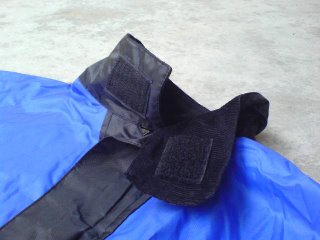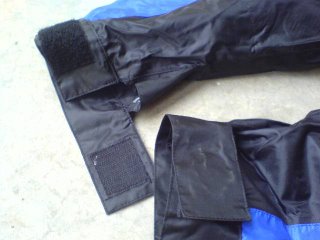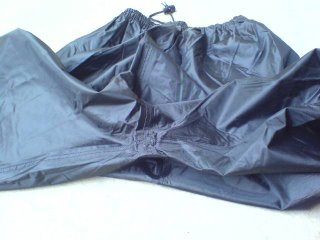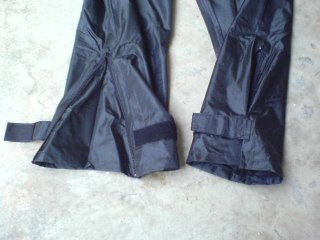It took 10 years of searching to find the answer that everyone is looking for.
Singapore is in the equator. So always rain. Or rather, it always like to rain whenever I ride.
Especially after I just washed my bike.
So one essential motorcycling gear to ride in Singapore is the rain coat.
But which motorcycling rain coat is most suitable for riding in Singapore weather?
Don't laugh. No small matter ok.
There are so many different brands of rain coat in the market. Got cheap one got expensive one.
You can dee-kam-dee-kam go and buy one. But if you suay, like me many times before, buy one that got small problem here and there, you become stucked with one lousy rain coat.
And it is very painful to be stucked with one lousy rain coat.
Because if you throw it away, your heart pain.
But if you don't throw away and use it, when kena heavy rain, you curse in agony.
So it is living hell.
Altogether, I have owned about 6-8 different sets of popular brands of rain coat.
Since I have never buy the same rain coat before, it shows that how difficult it is to find a "normal" rain coat that does the simple functions of keeping you dry and last well.
Until now.
Recently I was forced to buy another new suit of rain coat because my old one, which is still very new, leaked water. After using my new rain coat for a couple of months, I am very pleased with its result and wish to share with you my joy.
What brand of rain coat is it?
ProGrip Rain Coat

I will tell you why I am so happy with this ProGrip Rain Coat. The good thing is that it is not even expensive.
You see, for rain coats, there are a few key areas that rain tend to get in.
That is despite your rain coat is the most famous, most branded and most expensive.
The favourite areas that rain coats tend to leak water in are:
1. Neck Area.
2. The whole zip area in the middle.
3. The sleeve openings.
4. The groin area.
You don't even need to have all 4 problems. All you need is one of this area and you will get very miserable at the end of a ride.
And for me, if I get even a little wet when I go to work, I'll be in big trouble.
Because you see, I work in an office environment which has a lot of see-lang meetings.
So I wear white long sleeve shirt. The material is very thin so one drop of water on the shirt will spread into a big patch like baby urine on diapers like that.
And I wear long dark cotton pants. If my groin area gets wet, it is very malu to work around the office with a dark patch around your groin area.
Luckily, the ProGrip rain coat mostly survives all of the 4 areas.
1. Neck Area

The ProGrip has a decent turtle neck design with velcro.
A good neck design should be high enough such that it extends all the way to within and touching your helmet. If it is midway, water will drip down from your helmet and into your body.
A good neck design should also have very strong velcro. Otherwise, when riding at expressway speed or northsouth highway speed, the overlap strap will get blown open by the strong windblast. Then you will also get wet unless you ride with one hand cupping your neck.
The ProGrip neck design is high enough and the velcro is strong enough.
It has kept my neck area dry for all my rides so far. But I must warn that it is still possible for very slight bit of water to drip down from your helmet into your neck, unless you velcro around your neck until 100% watertight.
2. Front Zip
This part is very vulnerable for most rain coat because the wind blast strikes us square in our chest (unless you ride a full or sport tourer with a big screen). So water will be forced through the zip like high pressure water jets.

The ProGrip design is super kiapsu and super excellent. It has 2 overlap areas around the zip. One on outer-layer and inner-layer. The outer overlap layer prevents rain from directly blasting into the zip. Most other good rain coats have this design. But somehow it is not enough because I still often get wet after a heavy rain.
The ProGrip's inner overlap layer prevents water that got through the outeroverlap layer and past the zip, from touching your shirt.
I get reach office and remain completely dry even after a heavy rain and people will be surprised that I rode to work.
3. Sleeve Openings

The riding position on my Yamaha Fazer1000 is such that it is what is called doggie-beg position. So my lower arm is almost parallel to the ground. This means that rain will blow straight into my long sleeves if the sleeve design is weak.
The ProGrip sleeves have normal velcro design. There is a slight folded extension area. I always thought this part will let water in. But somehow, it never and my long sleeves always remain dry.
So this part also past the test.
4. Groin Area

This is often a problematic area. My previous still-grossily-new rain coat leaks water here.
For most bikes, we grip our legs snuggly around the fuel tank. So whenever we ride in the rain, our chest catch water like a reservoir catchment area. All these water then flow downards and accumulate around our groin area which grips around the fuel tank. After only 10 min of riding, a pool of water can collect around that area when we are riding.
And if we try to move our groin to release the water pool, the water tends to flow downwards onto the seat and gets trapped between the seat and the groin area of our rain pants.
If your rain coat's rain pants design is not good, it may start to leak water around the pants groin area even when it is brand new. If it doesn't, after wear and tear, it may eventually still leak.
The ProGrips's pants area is good enough that my groin area stays dry so far, even considering my bike's design tends to trap a lot of water between the big foamy seat and my pants.
So I am very pleased with this. Of course, if after wearing 1 year and water starts to leak in because the seams no longer becomes waterproof, I will not blame ProGrip.
Other Good Things

Another good design of ProGrip that I especially like is the big bell-bottom openings of the rain pants.
This is very important to me as sometimes, I wear basketball shoes which are very chunky. If the rain pants openings are not big enough, I will have to take off my shoes to put on or off the rain pants.
The bigger the pants openings, the more it is a breeze and the faster it is you can put on your rain pants at the side of the expressway when it suddenly rains.

The ProGrip has a vented rear opening. This is important for keeping the rider cool when riding through the rain for more than 10 minutes in Singapore's hot weather.
Where to Get and How Much
Guess how much to pay for this ProGrip rain coat that passed my difficult tests?
Not $100.
Not $80.
Not $50.
Only $35 niah!
Available from Regina/Ah Boy from Jalan Besar/Kelantan Lane.
Another next best rain coat I would recommend is from OGK.
OGK has different models of rain coat. The one that I recommend cost around $85.
Rain Shoes
Many people care about rain coat. But they don't care about keeping their feet dry.
I see before people wearing pink plastic bags wrapped around their feet.
I bought before rain shoes. But they tend to tear or break open around the seams. Some times as soon as within 2 weeks of buying them.
So I decided to look for something made of stronger material.
This is the rain shoes that I am currently using.


The good thing about this design is that there are no seams at the front or rear. So it wouldn't tear easily. The material is also very strong.
And of course, they keep my shoes completely dry.
The disadvantages of this boot cover are:
1. It feels very loose.
So I get around this problem by tying army shoe lace around my ankles.
This way, the rain shoe sole sticks closely to my actual shoe.
2. It is more bulky than most rain shoe design because of its thicker sole.
So you need more space to store.
I don't have a problem with this as I have panniers.
Where to Get and How Much
From Regina/Ah Boy at Jalan Besar/Kelantan Lane again.
I a bit forget how much liao. But around $50-30 (please don't steal my rain shoes when I sun them on my bike hor!)
Gloves
I think the minimum riding protection in Singapore is to wear gloves (besides wearing helmet securely).
There are also many many many different types of brands and design of riding gloves with varying budgets.
My priorities for riding gloves are these:
1. Must be fully made of leather
Both palm portion and top portion.
Because you never know if you would be sliding on the road surface with your palm facing up or facing down.
All fingers must be covered in leather.
The problem of this priority is that this means that the leather glove will end up very expensive.
The expensive ones can cost over $500!!!
2. Must not have carbon or kevlar protector on top of the hand
This is a common design nowadays as it protects your hand when it slides palm up on the tarmac.
The problem for me is that I got ku-niang hands. My hands are very sensitive so the carbon/kevlar backing poke my hands and made them very uncomfortable as I grip around my handle bar.
So I rather have gloves with traditional cotton/leather padding or totally no further extra padding.
3. Must be cheap
Less than $100 because otherwise I will spend more on my hands than on my head.
No lah. It is more like I poor and niao.
How to get a full leather glove at less than $100?
Rays Leather Glove

This is the riding glove that I use for daily commuting and for touring up north.
Every part is made of leather.
It is from RJays, an Australia brand. So the stiching is all good quality. Have been using everyday for almost a year and no seams are falling apart yet.
The disadvantages of this glove are:
1. Has no carbon/kevlar backing
So less protection. But Singapore riding speeds of up to 100kmh, since it is made fully of leather, I think it is good enough.
2. Single layer leather design
Those more expensive branded leather gloves have an inner lining plus the back might have an extra leather layer.
RJays one has only one layer. But to me, it is good enough as once again, for Singapore riding speeds, single-layer leather is tough enough.
How much and where to get?
My constraint is that it must be less than $100.
The RJays leather glove cost me $25 only.
For that price, I may not even be able to buy another half-leather-half-cloth glove design.
Once again, you can get it from Regina/Ah Boy.
Oi, I not advertising for them.
It is just that I cheapo. Always go there first to source for things.
Slightly more information can be found if you go to RJays website at:
http://rjays.com.au/home/products/gloves-summervent-glove.html
Another very useful kit I have and recommend
This one not absolutely essential for riding in Singapore.
But it is made such a difference to my riding life that I thought I should just share.
You see, I am a damn idle person. I hate to lube my bike's chain every 1-2 weeks.
So my Frost has a Scott Oiler.

I have rode my Frost for a year now, every day and up to almost Thailand.
And I have not lube my chain once.
The Scott Oiler does it for me.
How many hours of my life has the Scott Oiler saved me?
Oh, what a life saver!
It cost about $100. Available from MotorWorld, Kaki Bukit. But it is worth the price if you go and do your sums and put a per hour price to your time. The oil refill is very very cheap. A $12 bottle can last you for half a year. Cheaper than the lube chain spray.
My Scott Oiler is installed under my bike seat.
I also wish to correct a common thinking of Scott Oiler: You need a double drip system to drip both sides of your bike chain.
You don't need to. My Scott Oiler has a single drip system. The single drip only drips onto the outer side of my chain. But somehow, the centrifugal force of the movement of your chain will force the oil to flow and drip onto the inner side. Amazing!
I sure or not? Yes. I have been using for a year and I can see that the O-rings of both sides of the chain are moist with oil.
Parting Advice
End end is just around the corner. This means two things: The rainy season is going to start; And accident rate is going to go up.
I consider rain coat as an integral part of safety protection gear for Singapore riding.
How come? Rain coat thick enough to act as protection meh?
No. It is not.
But you see, if you do not have rain coat, once it starts to rain, your riding behaviour will change that increases your probability of getting into accident.
If you have no rain coat, a drizzle starts to fall when you ride and you are 5 min from your destination, you will ride faster and hope to cut down your exposure under the rain right?
Doesn't this increase your risk profile by increasing riding speed on a wet road with reduced visibility and riding with a reduced awareness intend on minimising getting wet?
Within a year of riding, easily would go through at least 12 times of getting caught in the rain riding. That means easily 60 min of high-risk-profile riding. How long do you think you can get away with it before something happens?
Or if you can be like me. If you are fully decked in proper rain gear, you know that you will get to your destination dry like a piece of paper. So I don't rush when I ride in the rain. I ride slower and keep a greater safety distance and hightened my awareness due to lower visibility for myself and other vehicles.
In fact, I enjoy riding in the rain. Because it is cooling. It gives me a chance to be a child again. To be in the rain (but stay dry), to feel rain droplets on my hand (the only exposed part), to see rain droplets on my visor. To feel completely dry when I see so many other motorcyclists huddling together under the flyovers. Strange isn't it? Some of them can afford to spend $20,000 to buy a fancy big bike and can't spend $35 to buy and carry a rain coat.
Compared with how much is your life worth. Just calculate how much you earn or will earn in a year.
Compared to the total cost of a rain gear (<$100). Oh, don't forget to change your tyres if your grooves are no longer deep as that will invite hydro-planning effects (means your bike can easily skid when the road is wet). Once again, compared the cost of a set of new tyres to how much you earn in a year. Isn't your life worth it? In any case, sooner or later you also need to change tyres one what. Might as well have new set when you really need it now that the season is wet, right? So, go to your mechanic or Regina/Ah Boy this weekend.